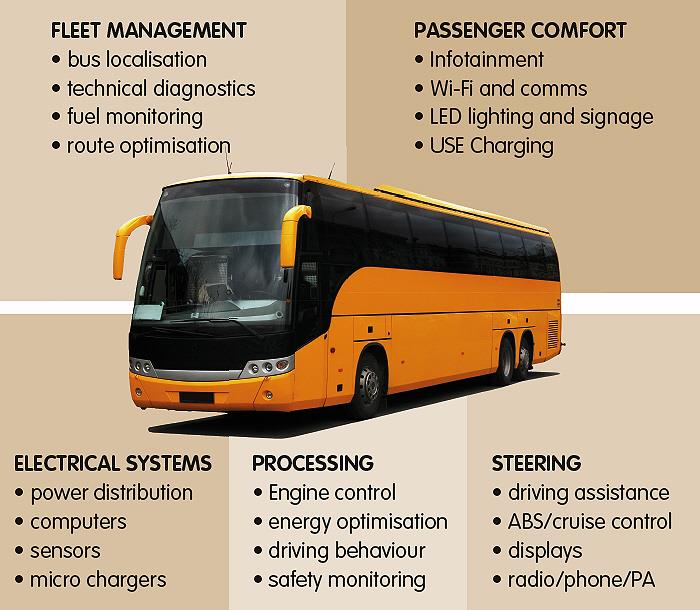Currently, almost everyone is talking about Industry 4.0 – the fourth industrial revolution. Industry 4.0 provides for what some call a ‘smart factory’. Within modular structured smart factories, cyber-physical systems monitor processes, creating virtual copies of the physical world and enabling decentralised decisions. Over the IoT, cyber-physical systems can communicate and cooperate in real time, not only with each other, but also with humans. And, via the Internet of Services, both internal and pan-organisational services are offered and used by members of the supply chain.
The effects of applying Industry 4.0 to the automotive industry can be translated into an Industrial Automotive 4.0 concept.
In 2016, more than 60% of cars were equipped with a colour screen as part of the infotainment system and the demand on the quality of the information delivered to the driver and passengers is very high. We all expect the same user experience in our cars as we get from our personal devices, home entertainment and high speed connectivity. These increased expectations add complexities in interoperability and safety for the auto-manufacturers, especially when considering the promise of 5G and intelligent vehicles.
Whilst the display is the obvious visible part of the ‘iceberg’, a lot of computing, sensors and other componentry make cars safer and more reliable. But, collectively, they require increasingly efficient and robust power solutions. In the car industry, power management is often achieved by a set of power management ICs (PMIC), part of the centralised embedded computer system. Semiconductor manufacturers offer a wide range of PMICs, with the latest generation including digital control and advanced communication interfaces.
While the car industry represents the mass market for automotive infotainment systems, growing demand for inter-city travel means existing train networks are often insufficient on their own and require complementary fleets of buses to enable passengers to reach destinations effectively.
A recent study found the global demand for bus travel is projected to grow at more than 5% per annum by 2018 – twice as fast as it grew between 2008 and 2013. The number of buses in use worldwide is expected to exceed 8million units in 2018 and many will incorporate advanced infotainment and fleet monitoring equipment. This, in turn, will require stable and reliable power solutions.
Demand for embedded communications
As with airplanes and the new generations of high-speed trains, infotainment equipment is often installed in passenger seat, requiring local power sources immune from line disturbances, low levels of radio-emissions and the ability to work without forced air cooling. In addition, bus manufacturers are requiring seat-manufacturers to make seats simpler and easier to maintain (and upgrade), with less cabling and interconnections.

To satisfy these requirements, seats will need simplified connectivity, limited to only one power cable and an optical fibre for data-transmission. This, in turn, means the power source for the infotainment equipment must be installed within the seat, placing high demand on power supply manufacturers.
For decades, power supplies for such equipment used to be located beneath seats, where free air convection cooling could be effective. However, the latest power modules must operate without airflow and therefore need to be designed for conduction cooling – a baseplate connected to the seat armature. To reduce power losses and to optimise cooling, power converters require very high efficiency ratings with dissipative components connected directly to the baseplate. Technologies used in high power density converters for the telecommunication industry – such as planar transformers, thermal vias, thermal drains and, in some case, heat pumps – are now being implemented throughout the automotive industry.
Patrick Le Fèvre
Powering infotainment and systems in industrial automotive applications demands that power converters comply with international standards, such as ISO7637, which addresses electrical disturbances for conducting and coupling test conditions for road vehicles using 12V or 24V batteries. This requires power supply developers to work in close cooperation with equipment manufacturers to ensure the final product operates in full compliance with their environments.
Fleet tracking
Appreciation is rarely given to the fact that modern buses are equipped with an impressive array of advanced electronics equipment requiring stable and sustainable power supplies. For reliability and optimisation of fleet management, new generations of buses are equipped with real-time tracking capabilities connected to the navigation system, engine conditioning and safety equipment, such as driving behaviour analysers. Monitoring systems report continuously on the status of the vehicles, making it possible to also manage preventive maintenance and report the positioning of the fleet to a central coordinator.
For safety reasons, if the main battery power was to fail, strategic systems would require local batteries and micro-chargers. These micro-chargers share similarities with infotainment power supplies in that they are often installed in confined environments. Thus, they share a need for high efficiency designs optimised around thermally managed conduction cooled mechanical formats. Designing to mitigate potential failures caused by thermal stress is vital and contributes towards high reliability units on the road.

Designers must also take into consideration specific demand for battery charging optimisation – measuring battery temperature, for example and, in some cases, communication between the battery charger and a central monitoring system – but also footprint standardisation for inventory and installation simplification. Such considerations need to be applied during the design process, with suitable comparisons being made between the performance of previous generations of products – mainly based on analogue control – and the latest generation, which integrate MCUs and real time charging optimisation.
Some would argue that adding digital control in a microcharger is ‘overkill’ for such applications, whilst others would claim that the technology has already proven benefits in terms of reliability and longer battery life-time.
But, whatever the arguments, due consideration needs to be given to the number of power sources required to supply stable and reliable voltage to infotainment and other electronic equipment employed on buses.
Bus manufacturers and industrial transportation are increasingly requiring power supply manufacturers to develop standardised DC/DC converters, chargers and step down regulators that are easily installed, maintained and capable of providing higher levels of power when upgraded. The concept of ‘one package to fit all’ is no longer a dream; it has become reality and has added challenging mechanical constraints to the unit’s design parameters.
For designers, there are opportunities to bring advanced power technology to a segment that has historically been slow at adopting new technologies. New generations of buses with modern infotainment and an impressive array of advanced electronics equipment will require developers to take big steps forward towards Automotive 4.0.
Perhaps those early adopters are right to call this the fourth industrial automotive revolution.
Author profile
Patrick Le Fèvre is chief marketing and communications officer with Powerbox













